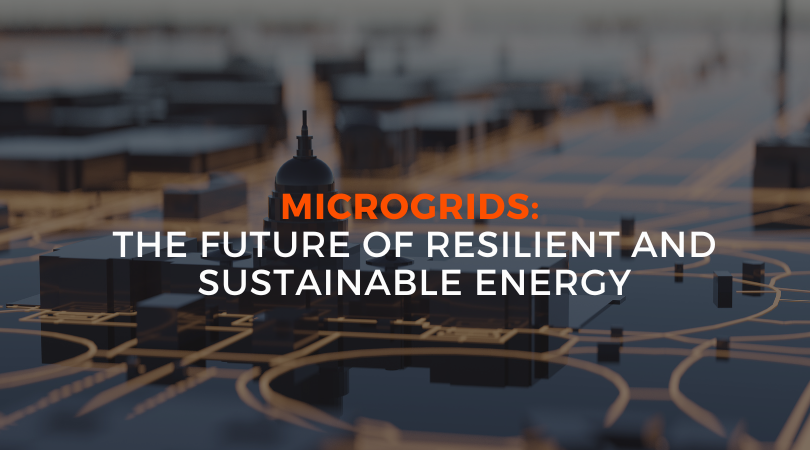Microgrids: The Future of Resilient and Sustainable Energy
As we face increasing challenges from climate change, power disruptions, and the growing need for sustainability, the traditional energy grid is no longer enough. Enter microgrids—innovative, decentralized energy systems that are transforming the way we think about power.
Microgrids offer a smarter, more flexible solution to energy management, blending renewable energy sources, advanced technology, and resilience into one seamless system. Whether it’s keeping critical infrastructure running during a blackout or reducing a community’s carbon footprint, microgrids are paving the way for a more sustainable and reliable energy future.
What Exactly Is a Microgrid and Why Does It Matter?
At its core, a microgrid is a localized energy system capable of operating independently or in conjunction with the larger power grid. It consists of interconnected loads and distributed energy resources (such as solar panels, wind turbines, batteries, and backup generators) that can be controlled as a single entity. A microgrid can operate in two modes:
- Grid-connected: When the main grid is functioning normally, the microgrid works alongside it, distributing power and improving efficiency.
- Islanded mode: When the main grid is down, a microgrid can disconnect and operate autonomously, providing a continuous supply of power to critical infrastructure, businesses, or communities.
The Building Blocks of a Microgrid: What Makes It Work?
A fully functioning microgrid typically includes:
- Distributed Energy Resources (DERs): These are the renewable or non-renewable energy sources (such as solar, wind, or natural gas generators) that generate power.
- Energy Storage Systems: Batteries or other storage solutions that allow the microgrid to store excess energy for use during peak demand or grid outages.
- Control Systems: Advanced software and hardware that manage the flow of energy within the microgrid and ensure efficient operation, switching between grid-connected and islanded modes as needed.
Why Microgrids Are the Key to the Future of Energy
Boosting Energy Resilience: Your Power, Always On
Microgrids enhance energy resilience by ensuring a continuous power supply, even during grid outages. In critical sectors like healthcare, data centers, and manufacturing, power disruptions can cause major financial and operational challenges. Microgrids offer a fail-safe solution, keeping essential systems running smoothly, regardless of external grid failures.
Achieving Energy Independence: Take Control of Your Power
Microgrids give businesses and communities more control over their energy generation and consumption. In remote or off-grid locations, where reliable grid access is limited, microgrids enable local energy production using renewable resources or backup generators. This independence leads to more stable and reliable power.
Driving Sustainability: The Green Revolution with Microgrids
Microgrids support the transition to a more sustainable energy future. By integrating renewable energy sources like solar and wind, microgrids help reduce reliance on fossil fuels and cut carbon emissions. With advanced storage systems, excess energy is stored for later use, ensuring a balanced supply that meets demand and promotes sustainability.
Cost Savings and Efficiency: More Power for Less
By optimizing energy use and avoiding peak-time charges from the main grid, microgrids offer significant cost savings. The integration of advanced control systems maximizes operational efficiency, allowing businesses to reduce energy costs while enhancing performance and resource management.
Elevating Power Quality and Reliability: Always Reliable, Always Safe
Microgrids ensure superior power quality and reliability. They are capable of quickly responding to voltage fluctuations and power surges, making them vital for sectors where a power failure—even for a brief moment—can have disastrous consequences. Hospitals, data centers, and manufacturing facilities can rely on microgrids to maintain stability and protect critical infrastructure.
Making an Impact: Microgrids and Environmental Sustainability
Microgrids reduce greenhouse gas emissions by promoting the use of renewable energy and optimizing energy consumption. As more businesses and communities adopt these systems, they are contributing to a cleaner and more sustainable global energy footprint.
Microgrids in Action: Revolutionizing Critical Infrastructure
A Lifeline for Critical Infrastructure: Power When It Matters Most
For industries like healthcare, finance, and manufacturing—where power outages can lead to significant disruptions—microgrids are a game-changer. By ensuring uninterrupted power, microgrids safeguard operations, prevent downtime, and protect valuable equipment.
Smart Energy Management: Predict, Optimize, and Save
Microgrids offer predictive energy management, using advanced systems to forecast energy needs and optimize usage. This intelligent approach reduces the risk of power disruptions, enhances operational efficiency, and maximizes savings—all while ensuring energy security for critical facilities.
Meeting Regulatory Goals: A Green Solution for Compliance
In addition to improving operational resilience, microgrids can help businesses meet energy and environmental regulations. By incorporating renewable energy sources and reducing emissions, companies can demonstrate their commitment to sustainability while fulfilling compliance requirements.
Looking Ahead
With growing energy demands and the increasing frequency of climate-related events, microgrids are emerging as essential solutions for future-proofing energy infrastructure. These systems provide not only reliable backup power but also facilitate the integration of renewable energy, making them a critical tool in the ongoing energy transition.
As technology continues to evolve, microgrids are becoming increasingly efficient, reliable, and accessible. Innovations in energy storage, grid optimization, and software controls are driving further advancements in microgrid technology, ensuring that they are a practical and viable solution for all types of businesses.
Microgrids Are the Future—Are You Ready?
By boosting resilience, promoting sustainability, and offering cost savings, microgrids are transforming how businesses and communities manage their power needs. Whether you’re looking to enhance your energy security or reduce your environmental impact, now is the time to invest in microgrid technology.
At Donwil, we are committed to helping our clients implement cutting-edge critical infrastructure solutions, including microgrids, ensuring businesses and communities remain powered and resilient no matter the challenges ahead.

